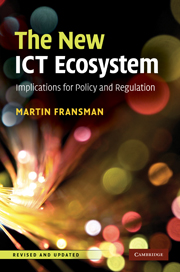Book contents
- Frontmatter
- Contents
- List of exhibits
- Preface
- List of abbreviations and acronyms
- Introduction
- 1 Summary of the argument
- 2 The new ICT ecosystem: architectural structure
- 3 The new ICT ecosystem as an innovation system
- 4 The new ICT ecosystem: a quantitative analysis
- 5 Telecoms regulation
- 6 Policy-making for the new ICT ecosystem
- 7 The way forward: the message to policy-makers and regulators
- Appendixes
- 1 The evolution of the new ICT ecosystem, 1945–2007: how innovation drives the system
- 2 European regulation of electronic communications, 1987–2003
- 3 Some problems with the dominant regulatory paradigm in telecoms (DRPT)
- 4 A short introduction to Schumpeterian evolutionary economics
- 5 Other layer models: OSI and TCP/IP
- 6 Content, applications and services: definitions
- 7 Why do US Internet companies dominate in layer 3?
- 8 How did East Asia (Japan, Korea, Taiwan and China) become so strong in layer 1?
- 9 China's telecoms service providers in layer 2
- 10 Companies in our database, by layer
- Bibliography
- Index
8 - How did East Asia (Japan, Korea, Taiwan and China) become so strong in layer 1?
Published online by Cambridge University Press: 04 May 2010
- Frontmatter
- Contents
- List of exhibits
- Preface
- List of abbreviations and acronyms
- Introduction
- 1 Summary of the argument
- 2 The new ICT ecosystem: architectural structure
- 3 The new ICT ecosystem as an innovation system
- 4 The new ICT ecosystem: a quantitative analysis
- 5 Telecoms regulation
- 6 Policy-making for the new ICT ecosystem
- 7 The way forward: the message to policy-makers and regulators
- Appendixes
- 1 The evolution of the new ICT ecosystem, 1945–2007: how innovation drives the system
- 2 European regulation of electronic communications, 1987–2003
- 3 Some problems with the dominant regulatory paradigm in telecoms (DRPT)
- 4 A short introduction to Schumpeterian evolutionary economics
- 5 Other layer models: OSI and TCP/IP
- 6 Content, applications and services: definitions
- 7 Why do US Internet companies dominate in layer 3?
- 8 How did East Asia (Japan, Korea, Taiwan and China) become so strong in layer 1?
- 9 China's telecoms service providers in layer 2
- 10 Companies in our database, by layer
- Bibliography
- Index
Summary
One of the key features of the global new ICT ecosystem is the prominent position enjoyed in layer 1 – the networked elements layer – by leading companies from four East Asian countries: Japan, Korea, Taiwan and China. But how did these countries and companies come to achieve international competitiveness in layer 1 in areas that were hitherto dominated by US and European rivals? This question is dealt with in this appendix.
East Asian global competitiveness in the new ICT ecosystem
Exhibit A8.1 demonstrates East Asian global competitiveness in the new ICT ecosystem. It contrasts four areas of considerable strength, all in layer 1 (telecoms equipment, semiconductors, computers and consumer electronics), with the medium strength of selected East Asian companies in layer 3.
As can be seen fromexhibit A8.1, Japan is very strong in terms of global competitiveness in telecoms equipment, semiconductors (particularly memories) and consumer electronics. Furthermore, it is strong in computers. In the upper layers, however, Japan is of medium strength (NTT DoCoMo's i-mode mobile Internet service, which is very strong, being an example of a significant exception).
Korea is very strong in semiconductors (including memories and displays) and consumer electronics.
- Type
- Chapter
- Information
- The New ICT EcosystemImplications for Policy and Regulation, pp. 197 - 217Publisher: Cambridge University PressPrint publication year: 2010



